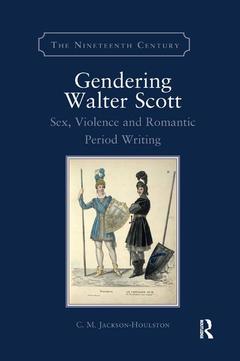Description
Gendering Walter Scott
Sex, Violence and Romantic Period Writing
The Nineteenth Century Series
Author: Jackson-Houlston C.M.
Language: English
Keywords
Young Man; Ration Ality; Vice Versa; Sir Arthur Wardour; Amy Robsart; Oriental Tale; Magnum 25a; Romantic Period Writing; Meg Murdockson; George III; Magnum 25b; Madge Wildfire; Flora Mac Ivor; Mount Henneth; Catherine Seyton; Edith Bellenden; Conventional Gender Ideology; Effie Deans; Jeanie Deans; Meg Merrilies; Mause Headrigg; Ariosto’s Bradamante; Robin Hood Stories; Scott’s Heroines; Guy Mannering
Publication date: 12-2019
· 15.6x23.4 cm · Paperback
Publication date: 04-2017
· 15.6x23.4 cm · Hardback
Description
/li>Contents
/li>Biography
/li>
Employing gender as a unifying critical focus, Caroline Jackson-Houlston draws on the full range of Walter Scott?s novels to propose new links between Scott and Romantic-era authors such as Sophia Lee, Jane Porter, Jane Austen, Sydney Owenson, Elizabeth Hands, Thomas Love Peacock, and Robert Bage. In Scott, Jackson-Houlston suggests, sex and violence are united in a central feature of the genre of romance, the trope of raptus?the actual or threatened kidnapping of a woman and her subjection to physical or psychic violence. Though largely favouring the Romantic-period drive towards delicacy of subject-matter and expression, Scott also exhibited a residual sympathy for frankness and openness resisted by his publishers, especially towards the end of his career, when he increasingly used the freedoms inherent in romance as a mode of narrative to explore and critique gender assumptions. Thus, while Scott?s novels inherit a tradition of chivalric protectiveness towards women, they both exploit and challenge the assumption that a woman is always essentially definable as a potential sexual victim. Moreover, he consistently condemns the aggressive male violence characteristic of older models of the hero, in favour of restraint and domesticity that are not exclusively feminine, but compatible with the Scottish Enlightenment assumptions of his upbringing. A high proportion of Scott?s female characters are consistently more rational than their male counterparts, illustrating how he plays conflicting concepts of sexual difference off against one another. Jackson-Houlston illuminates Scott?s ambivalent reliance on the attractions of sex and violence, demonstrating how they enable the interrogation of gender convention throughout his fiction.
CONTENTS
Chapter 1 Introduction
Chapter 2 ‘Hardly any women at all’?: Gender and genre
Chapter 3 Witches, bitches, gipsies: women and psychic power
Chapter 4 ‘Fanaticism … in the face of the Father?’: The displacement of the feminine in Rob Roy and romantic treatments of rape
Chapter 5 ‘The full force of sisterly sorrow’: the ethics of justice in TheHeart of Mid-Lothian
Chapter 6 ‘A barbarous, unfeminine use of power’: romantic constructions of renaissance Queenship
Chapter 7 Fathers of their countries? Scott, Porter and male rulers
Chapter 8 ‘A dingy or damaged commodity’: circulation, honour and commodification in Scott’s Saint Ronan’s Well
Chapter 9 ‘She herself must venture … beyond the prescribed boundary’: the construction of gender and cultural difference through four Orientalist fictions
Chapter 10 ‘Men of blood’ and ‘the speech of a woman’
Chapter 11 Mountain maidens and cowgirls: exercise, athleticism, and its ideological constraints for several Scott heroines
Chapter 12 Women warriors and other outlaws
Chapter 13 Conclusion
Select bibliography
Index
Caroline Jackson-Houlston has forty one years' experience teaching Romanticism at Oxford Brookes University, UK and contributed to the Edinburgh Edition of the Waverley Novels for twenty five years as a consultative editor for folksong allusions.




